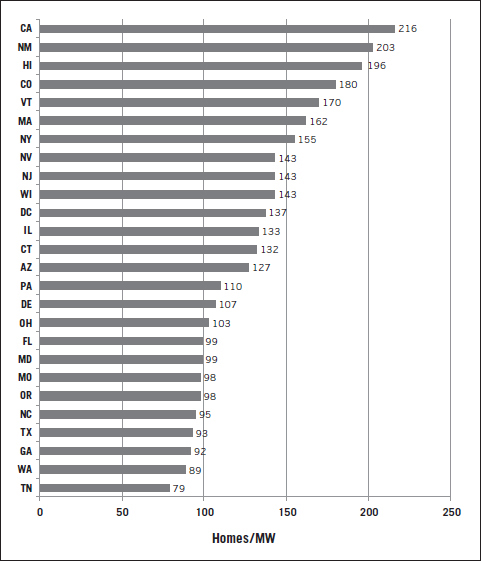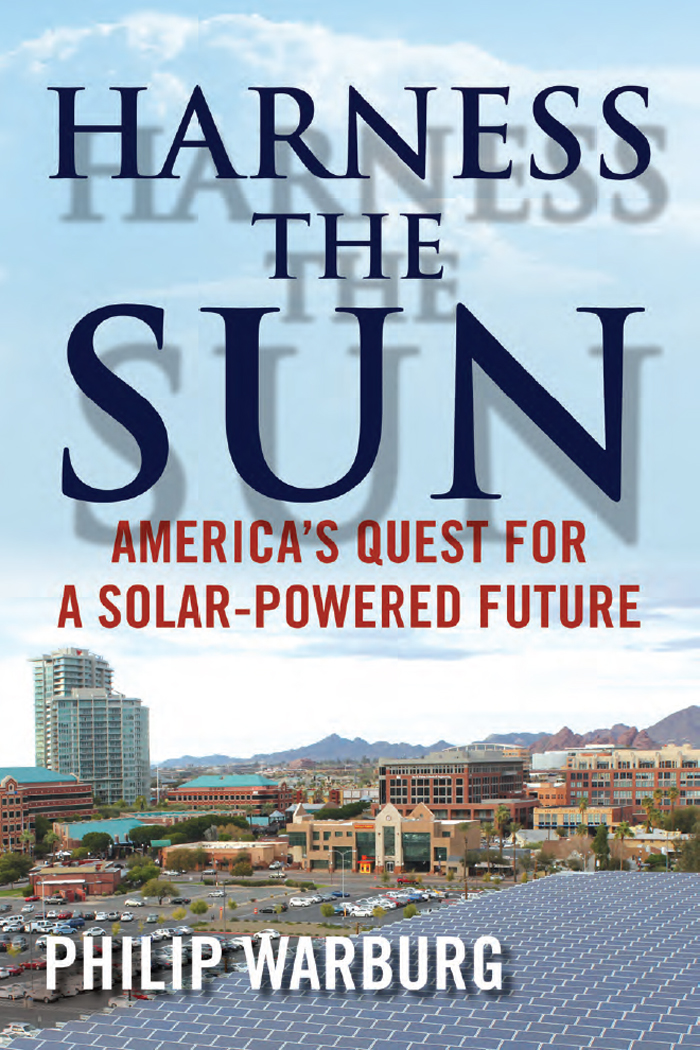HARNESS
THE
SUN
AMERICAS QUEST FOR
A SOLAR-POWERED FUTURE
PHILIP WARBURG
BEACON PRESS, BOSTON
CONTENTS
Note on Terminology
IN THE PAGES THAT follow, I describe solar installations of highly diverse scale, from small arrays serving individual households to giant solar farms that send huge infusions of power to the grid. Most of these systems rely on the photovoltaic effect, which uses the energy in particles of sunlight, or photons, to create electricity. A photovoltaic (PV) panel, also called a module, consists of multiple PV cells. The direct (DC) current generated by these cells must be converted to alternating (AC) current before it can be used by our electric system.
In some larger solar installations, the suns heat rather than its light is captured and is then typically used to create steam for a conventional electricity-generating turbine. This latter approach, called concentrating solar power (CSP), is described in .
Individual PV panels have a few hundred watts of installed capacitythe maximum power that they can generate under standard test conditions (described more fully in ). Household-scale solar systems typically have a few kilowatts (1,000 watts) of installed capacity. Solar installations on commercial and public buildings commonly have hundreds of kilowatts of installed capacity, and larger commercial and utility-scale solar plants can have multiple megawatts (1 million watts) of installed capacity. When quantifying solar power at the state or national level, the gigawatt (1 billion watts) is often used as the unit of measurement. The actual amount of electricity produced by solar facilities (measured in kilowatt-hours, megawatt-hours, or gigawatt-hours) depends on numerous factors including weather, temperature, and the particular technologies employed.
The Solar Energy Industries Association (SEIA) estimates that a megawatt of installed photovoltaic (PV) capacity can supply enough electricity for 164 American homes. The actual number of homes served by a megawatt of solar power varies quite widely from state to state, however, depending on differences in climate and household electricity use. (See .) While there are many non-residential uses of electricity, the individual household is a favored metric for solar electric output because it is relatively immediate to most of our lives, and is therefore easy to understand.
Fig. 1 Average Number of Homes Powered by a Megawatt of Solar Photovoltaics (25 States & District of Columbia)

Source: Solar Energy Industries Association, Whats in a Megawatt, http://www.seia.org. These averages are affected by differences in climate and average household electricity use. Because of greater reliance on air-conditioning in some states with high solar irradiance, the average number of homes served by a megawatt of solar photovoltaics may be smaller in those states than in states with lower levels of solar irradiance.
Introduction
SOLAR ENERGYS TIME HAS COME. Just a few years ago, as I was putting the finishing touches on a book about wind power, friends asked if my next would be about solar. I dismissed the idea at the time. If I ever wrote a book about solar, I told them, Id have to call it Dim Sun.
How things have changed! On my computer screen, I marvel at the steady tick of kilowatt-hours produced by our homes rooftop solar array. It generates about three-quarters of the electricity we need to run our appliances, light up our rooms, and keep a hybrid electric vehicle fully charged. Every year our solar panels spare the globe about 3.6 tons of CO2 emissions from the coal- and gas-fired plants that still supply most of New Englands power.
At last we have entered an era when solar energy is not just an environmental virtue but is also a boon to the economy. More than 640,000 Americans have already installed solar power on their homes and businesses, Those jobs will grow in the years ahead, as solar energy reaches millions of American homes, businesses, farms, public buildings, and the portfolios of power companies large and small. Over a century has passed since Albert Einstein identified the suns photoelectric effect in 1905a discovery that later earned him the Nobel Prize for Physics. I can only imagine how delighted he would be by our progress, however belated, in harnessing this formidable source of power.
It seemed that a new solar era was dawning in the years following the 1973 Arab oil embargo. President Jimmy Carter proclaimed a solar revolution, calling for a fifth of Americas energy to come from the sun by the year 2000. The first federally designated Sun Day was held in 1978, and the governments newly created Solar Energy Research Institute pressed ahead with a bold agenda for solar R&D. With strong bipartisan congressional support, Carter authorized tax incentives that created a burst of solar energy investment. While a few power plants were built using mirrors to concentrate the suns heat for electricity production, photovoltaic technologyconverting sunlight to solar powerremained a rare luxury, primarily used on satellites where the need for electricity in orbital space justified the exorbitant cost. Solar water heaters, much cheaper and easier to build, were of greater practical value here on earth, and Carteramid much fanfarehad one such system installed at the White House.
Then came the bust. In the 1980s Ronald Reagan purged federal support for renewable energy and ordered Carters solar water-heating panels stripped from the White House roof. Unable to compete with cheap western coal and deregulated natural gas, solar energys fate seemed to be sealed.
Yet today Americans are investing more money, and greater hope, in solar energy than ever before. Though solar energy has many applications, producing electric power from the sun has taken center stage as US and foreign companies vie for a share of this rapidly expanding market.
Much more than an echo of our earlier flirtation with renewable energy, solar power is part of a sea change that is sweeping through university labs, policy think tanks, and corporate boardrooms, where recognition is growing that a fundamental shift away from carbon-based fuels is imminent and inevitable. The devastating impacts of climate change may be too seldom acknowledged by our political leaders, but the overwhelming scientific evidence has persuaded technology innovators as well as broad segments of the public to embrace a major push toward renewable energy.
Solar electricity supplies less than half a percent of Americas power today, yet its no idle dream to foresee a quarter or more of our electricity coming from the sun in a few decades time. Imagine the impact that would have on Americas carbon footprint!
Despite all this promise, America has some catching up to do. We may have far greater land resources and sunnier weather, on the whole, than much of Europe, yet we lag far behind many European nations in our per capita use of solar power. Germany leads the world in both per capita and total use of solar energy, despite its notoriously gray climate. A highly publicized 100,000 Roofs Program got the ball rolling back in 1998, and vigorous subsidies raised that countrys solar power to 436 watts per person by 2013more than 11 times our own reliance on the sun, which stood at 38 watts per capita that year. Italy earned second place with 294 watts of solar power per person; next came Belgium, Greece, and the Czech Republic. In all, eighteen European countries delivered higher per capita solar use than the United States. (See .)








